


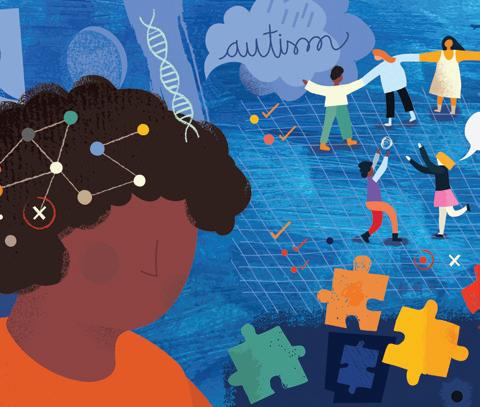
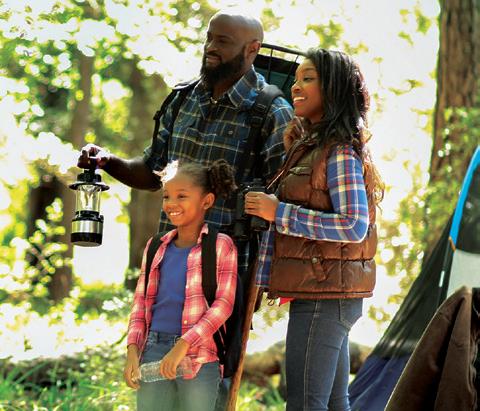






By
or older adults, fall is an important time to focus on health and wellness.
According to Ryan Kocher, who leads Medicare growth for HealthSpring, the new brand for Health Care Service Corporation’s Medicare business, formerly owned by the Cigna Group, the following three tasks are essential for seniors to complete as cool weather sets in.

An influenza vaccine can help prevent serious illness due to flu. As immune defense diminishes with age, older adults are increasingly susceptible to flu complications. The Centers for Disease Control and Prevention (CDC) recommends the use of higher dose flu vaccines for people 65 years and older. This fall, in advance of flu season, visit your healthcare provider or pharmacist to get the right vaccine for you. This is also a good time to catch up on any other immunizations that your provider recommends.
Medicare is the government health insurance program for Americans 65 and older and
others who qualify. Many Medicare beneficiaries choose or change their plans during the Medicare Annual Enrollment Period (AEP), which takes place between Oct. 15 and Dec. 7. HealthSpring is offering a host of Medicare options for 2026. The company provides these tips for selecting a plan:
Check for plan changes: Review your plan every AEP, especially if you’ve experienced changes to your health, lifestyle or finances. It’s especially important to read your Annual Notice of Change (ANOC) letter – delivered every September – to find out about any modifications to your current plan.
• Dig into the details: A good plan is one that includes your favorite providers and specialists and covers the medications you currently take. When reviewing plans, take these factors into consideration.
• Consider all your options: Medicare Advantage plans cover everything Original Medicare does, so do your research to see if these plans will work for you.
• Learn more: Before enrolling in a particular plan, be sure you understand the details. Call Medicare at 1-800-MEDICARE (1-800-633-4227) 24 hours a day, 7 days a week; TTY users can call 1-877-486-2048. Or, visit the Medicare Plan Finder website at Medicare.gov/plan-compare. For local assistance, refer to the State Health Insurance Assistance Program website at www.shiptacenter.org. You can also visit individual Medicare plans’ websites for more information. For example, HealthSpring’s website is www.healthspring.com.
Annual enrollment also serves as a good reminder to take advantage of all your Medicare benefits. Preventive care and a healthy lifestyle can help you maintain your independence and vitality as you age. Tap into what your plan offers so you can actively engage in your health and well-being.
By checking a few important items off your to-do list during autumn, you can ensure you’re well-positioned for a healthy winter and 2026.
Source: StatePoint
tional steps to filter, block and set boundaries.
PRACTICAL STEPS YOU CAN TAKE
hen graphic videos go viral, it can feel impossible to protect yourself from seeing things you did not consent to see. But there are steps you can take.
Social media platforms are designed to maximize engagement, not protect your peace of mind. The major platforms have also reduced their content moderation efforts over the past year or so. That means upsetting content can reach you even when you never chose to watch it.
WHY THIS MATTERS
Research shows that repeated exposure to violent or disturbing media can increase stress, heighten anxiety and contribute to feelings of helplessness. These effects are not just short-term. Over time, they erode the emotional resources you rely on to care for yourself and others.
Protecting your attention is a form of care. Liberating your attention from harmful content is not withdrawal. It is reclaiming your most powerful creative force: your consciousness.
Just as with food, not everything on the table is meant to be eaten. You wouldn’t eat something spoiled or toxic simply because it was served to you. In the same way, not every piece of media laid out in your feed deserves your attention. Choosing what to consume is a matter of health.
And while you can choose what you keep in your own kitchen cabinets, you often have less control over what shows up in your feeds. That is why it helps to take inten-
Fortunately, there are straightforward ways to reduce your chances of being confronted with violent or disturbing videos. Here are four that I recommend:
Turn off autoplay or limit sensitive content. Note that these settings can vary depending on device, operating system and app version, and can change.
SOCIAL MEDIA STEPS YOU CAN TAKE
Bluesky: Settings–Content and media-uncheck Autoplay videos and GIFs
Facebook app: Profile picture (Menu)-Settings-Media-Autoplay in Feed and Stories-Never
Facebook browser: Profile picture (Account)-Settings and privacy-Settings-Media-toggle off Autoplay animations
Instagram: Profile picture-Menu icon (three horizontal lines)-Content preferences-Sensitive content: Less; Suggest political content: Off; Specific words and phrases: add words
TikTok app: Profile button-Menu button (three horizontal lines)-Settings and privacy-Content preferences-Restricted mode: On; Filter keywords: add words
X website: More-Settings and privacy-Privacy and safety-Content you see-uncheck Display media that may contain sensitive content
YouTube app: You (Profile)-Gear icon (Settings)Playback-Autoplay next video-toggle off
YouTube browser: Settings-Playback and perfor-
mance-Browsing-toggle off Video previews
Use keyword filters. Most platforms allow you to mute or block specific words, phrases or hashtags. This reduces the chance that graphic or violent content slips into your feed.
Curate your feed. Unfollow accounts that regularly share disturbing images. Follow accounts that bring you knowledge, connection or joy instead.
Set boundaries. Reserve phone-free time during meals or before bed. Research shows that intentional breaks reduce stress and improve well-being.
Social media is not neutral. Its algorithms are engineered to hold your attention, even when that means amplifying harmful or sensational material. Watching passively only serves the interests of the social media companies. Choosing to protect your attention is a way to reclaim your agency.
The urge to follow along in real time can be strong, especially during crises. But choosing not to watch every disturbing image is not neglect; it is self-preservation. Looking away protects your ability to act with purpose. When your attention is hijacked, your energy goes into shock and outrage. When your attention is steady, you can choose where to invest it.
You are not powerless. Every boundary you set – whether it is turning off autoplay, filtering content or curating your feed – is a way of taking control over what enters your mind. These actions are the foundation for being able to connect with others, help people and work for meaningful change.
Source: The Conversation (Edited by d-mars.com)
By d-mars.com News Provider
ach year, 500 to 1,000 people in the United States are diagnosed with pulmonary arterial hypertension (PAH), a rare lung disease that can be fatal if left untreated.
To encourage earlier diagnosis of PAH, the American Lung Association, with support from Johnson & Johnson, is sharing information about the disease, its symptoms, and the importance of testing and proper treatment.
What is PAH? PAH is a rare, progressive lung disease caused when the tiny arteries in your lungs become thickened and narrowed. This blocks blood flow through your lungs, causing the blood pressure in your lungs to rise. The heart has to work harder to pump blood through the narrowed arteries. Over time, your heart has difficulty effectively pumping blood through your body.
What are the symptoms of PAH? In the early stages, you may not notice symptoms. As PAH progresses, common symptoms include shortness of breath, especially with activities like walking up the stairs or long distances, fatigue, edema (swelling of the feet, legs and eventually the abdomen and neck), dizziness and fainting spells, chest pain, heart palpitations, and lips and fingers turning blue. Contact your healthcare provider if you’re experiencing these or any worrisome symptoms.
Who is most at risk? While anyone can get PAH, those most at risk are women ages 30-60, and Black and Hispanic women.
Why is PAH difficult to diagnose? Because symptoms of PAH are similar to other diseases, the average time it takes to get a diagnosis is about 3 years. This delay can be frustrating for
patients and their families, and can result in poorer health outcomes. Unfortunately, health disparities exist due to a wide-range of factors, like lack of access to healthcare, health insurance coverage, transportation to specialists, and health literacy, and can exacerbate these delays. Increasing awareness of this rare disease can help patients get a quicker diagnosis so they can get the treatment they need.
How can the path to diagnosis be shortened? Your provider may order several tests to help with diagnosis:
• A simple blood test, the BNP test (also called B-type natriuretic peptide test) or NT-proBNP test, can help determine if your heart is working harder than it should, a sign that you may have PAH. Getting this test done early can help speed the path to diagnosis.
• Electrocardiogram to show the electrical activity of your heart.
• Echocardiogram to check the size and condition of your heart.
• Lung function tests.
• A right heart catheterization to confirm PAH, once your provider suspects it.
How is PAH treated? PAH-specific medications come in multiple forms: oral, inhaled and subcutaneous. Some allow blood to flow more easily through the arteries of your lungs. Others improve heart and lung function. PAH medications help slow how quickly your disease worsens. For optimal health outcomes when dealing with a rare disease like PAH, it’s best to see a specialist.
If you have unresolved respiratory symptoms that are not improving with your current treatment, learn more about PAH at Lung.org/pah.
Source: StatePoint (Edited by d-mars.com)
s parents, one of your top priorities is the safety and well-being of your children. With all the potential pitfalls of day-to-day life, however, navigating the risks can be difficult.
These everyday safety tips can help you navigate everything from car seat safety to baby-proofing and safe sleep, keeping your child out of harm's way as much as possible from birth through his or her toddler years.
1.
• Always use a valid (typically less than 6 years old), federally approved car seat in motor vehicles.
• Ensure the seat is properly installed. Refer to the instruction manual with any questions.
• If you use an infant carrier, strap your child in on the floor, never a counter or tabletop.
• For at least the first two years of your child's life, the car seat should be rear-facing.
• The safest location for a car seat is in the middle of the back seat.
2. CHOKING PREVENTION
• Avoid giving your child nuts, popcorn, hard candies, hot dogs and raw fruits and vegetables, such as grapes or carrots, that may present a choking hazard.
• Never prop up a bottle and leave your baby unattended.
• Inspect toys often to ensure they're not broken and
do not have small pieces that could easily become detached.
• Be cautious of strings and buttons on clothing.
3. SAFE SLEEP
• The safest place for your baby to sleep is on his or her back, which reduces the risk for Sudden Infant Death Syndrome (SIDS).

• Avoid placing anything in the crib or bassinet that may suffocate your child, such as pillows, blankets or bumpers.
• Keep your child's room at a moderate temperature and dress him or her appropriately to avoid overheating.
• Never leave your baby alone on a bed, couch, changing table, swing or infant seat.
4. WATER SAFETY
• Set your hot water heater no higher than 120 F.
• Test the temperature of bath water before setting your baby in the tub.
• Never leave your baby unattended in the bathtub.
• Keep toilet lids down and consider installing toilet lid locks.
5.
• Install smoke and carbon monoxide detectors on every level of your home and in every sleeping area.
• Secure cords on blinds and drapes out of reach.
• Keep sharp objects, such as knives, scissors and tools, and other hazardous items, like coins, beads and pins, in a secure place out of baby's reach.
• Store cleaning products and medications in locked cabinets. Never store potentially toxic substances in containers that could be mistaken for food or drink.
• Cover all electrical outlets.
• Cushion hard edges and sharp corners of furniture and decor.
• Secure cords to electrical items along baseboards using electrical tape.
• Attach heavy or tall furniture to the wall and avoid placing items that could fall, like electronics or lamps, on top of dressers or shelves.
• Install safety gates with straight, vertical slats securely in front of all stairwells.
Source: Family Features


By d-mars.com News Provider
n 1994, Karen Eubanks Jackson, a breast cancer survivor of over 30 years, founded Sisters Network® Inc. It stands today as the only national African American breast cancer survivorship organization. With more than 25 chapters across the country, the network is dedicated to bringing attention to the serious impact of breast cancer on our community. Through their work, thousands of women and their families receive vital support, education, and access to much-needed resources.
The facts about breast cancer in our community are startling. It is the most common cancer affecting Black women. We are 40% more likely to die from breast cancer than women of other backgrounds. This year, it's projected that over 40,000 Black women will be newly diagnosed, and tragically, more than 6,000 may lose their lives to the disease. A key reason for this is that our cancers are often found at a later, more advanced stage, making treatment more difficult. Furthermore, Black women are twice as likely as white women to be diagnosed with triple-negative breast cancer, an aggressive form of the disease that is harder to treat.
These numbers show exactly why the work of Sisters Network is so crucial. The organization is committed to meeting the specific needs of Black women, providing the support, information, and resources necessary for our breast health journey.
The Hyatt Regency Houston Galleria welcomed hundreds of survivors, advocates, medical professionals, and supporters, who gathered for the Sisters Network’s National Black Breast Cancer Summit on October 3-5. This purposeful and impactful weekend is dedicated to education, empowerment, and community among Black women affected by breast cancer.
The weekend began with a lively welcome reception sponsored by Lilly, where attendees

from Sisters Network affiliate chapters nationwide reunited in sisterhood and celebration. Jackson welcomed the women with a heartfelt message of purpose and gratitude.
“Over the next couple of days, we’ll learn, we’ll share, and we’ll lift each other as we celebrate the blessing of being together,” said Jackson. “Sisters Network is what it is because of women like you, those who roll up their sleeves, provide support in their communities, answer late-night calls, and show up in love. You are the heartbeat of this movement.”
Jackson also acknowledged the organization’s board members as well as affiliate chapter leaders, volunteers, and national partners who continue to drive the mission forward. The evening concluded with line dancing hosted by Jazzy Vee and a toast celebrating survivorship and unity.
Saturday’s Pretty in Pink Luncheon & Awards Ceremony, presented by Gilead Oncology, featured a soul-stirring live performance by gospel award-winning artist Evvie McKinney.
The mistress of ceremonies for the luncheon was Sharron Melton, an anchor with Channel 39. Among the day’s honorees, the Triangle North Carolina Affiliate Chapter received the prestigious Chapter of the Year Award, and Majic 102.1 radio personality Kandi Eastman was named Community Advocate Champion for her outstanding dedication to raising breast cancer awareness across Houston.

The summit’s educational sessions delved into topics at the intersection of innovation and equity in breast cancer care. Dr. Caroline Chung, M.D., MSC., FRCPC, CIP, led a fireside chat on artificial intelligence in breast cancer treatment, while Dr. Lisa A. Newman, M.D., FACS, discussed the disproportionate rates of triple-negative breast cancer (TNBC) among Black women. Attendees also participated in breakout sessions and explored exhibits featuring Pfizer, MD Anderson Cancer Center, and Black Girl Vitamins, among others.
Reflecting on the summit’s impact, Jackson shared, “When I founded Sisters Network, it was out of necessity and faith. Necessity because the data and experiences of Black women were being overlooked, and faith because I knew our community could lead the change. Since then, we’ve built a movement that centers survivors, educates the public, advocates for equity, and connects women to the care they deserve.”

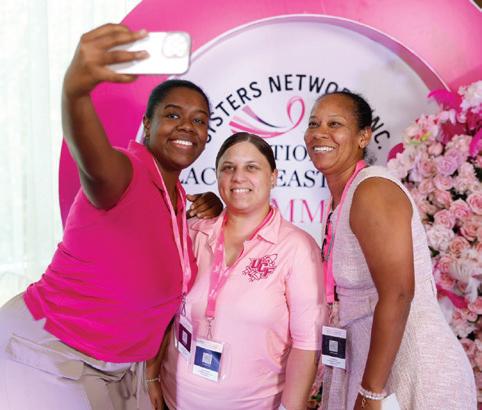

The Pretty in Pink Luncheon & Awards served not only as a celebration of survivorship but also as a call to action. “Today’s event is more than a beautiful moment; it is a recognition of strength, sisterhood, and service,” Jackson said. “It is also an opportunity to confront the reality that Black women continue to face later diagnoses and barriers to care. But we are not powerless. We are informed, organized, and relentless.”
The 2025 National Black Breast Cancer Summit concluded with a heartfelt gospel brunch. This summit reaffirmed Sisters Network’s commitment to saving lives through early detection, advocacy, and sisterhood. Sisters Network is committed to remaining the leading national voice for African American women in the fight against breast cancer.
For more information, visit www.sistersnetworkinc.org.
Source and Photo Credits: Sisters Network, Inc.

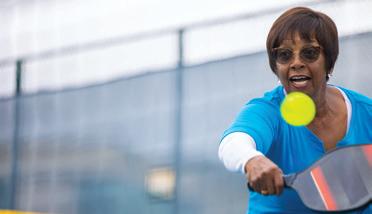




BBy d-mars.com News Provider
etween work, family obligations, and a constantly changing world, people in the United States are stressed. In fact, U.S. workers are among the most stressed in the world, according to a State of the Global Workplace study. While some stress is unavoidable and can be good for you, constant or chronic stress can have real consequences for your mental and physical health. This is because the body’s natural stress response, often called the “fight-or-flight” mechanism, is designed for short-term, acute threats. When this system is activated over and over again for prolonged periods, the persistent elevation of stress hormones like cortisol and adrenaline can wear down the body’s natural defenses.
Chronic stress can increase your lifetime risk of heart disease and stroke. It can also lead to unhealthy habits like overeating, physical inactivity and smoking while also increasing risk factors, including high blood pressure, depression and anxiety. This long-term activation of the stress-response system can disrupt almost all of your body's processes. For the cardiovascular system specifically, chronic stress can lead to inflammation in the arteries, which is a key factor in the development of atherosclerosis, or the hardening of the arteries. However, a scientific statement from the American Heart Association shows reducing stress and cultivating a positive mindset can improve health and well-being. Taking proactive steps to manage your daily stress is not a luxury; it is an essential component of a heart-healthy lifestyle.
To help people understand the connection between stress and physical health, the American Heart Association offers these science-backed insights to help reduce chronic stress.
Exercise is one of the easiest ways to keep your body healthy and release stress. Physical activity is linked to lower risk of diseases, stronger bones and muscles, improved mental health and cognitive function, and lower risk of depression. It can also help increase energy and improve quality of sleep. The American Heart Association recommends adults get at least 150 minutes per week of moderate-intensity activity, 75 minutes of vigorous activity or a combination. Moderate-intensity activities could include a brisk walk, water aerobics, or gardening, while vigorous activities might include running, swimming laps, or hiking uphill. The reason exercise works so well is that it boosts your body’s production of endorphins, which are natural mood elevators, and it can help decrease the levels of stress hormones in your body over time.
MEDITATE
Incorporate meditation and mindfulness practices into your day to give yourself a few minutes to create some distance from daily stress. Some studies show meditation can reduce blood pressure, improve sleep, support the immune system, and increase your ability to process information. Even a simple five-minute breathing exercise can be highly effective: find a quiet spot, sit comfortably, close your eyes, and focus solely on the sensation of your breath. The goal isn't to stop thinking, but rather to observe your thoughts without judgment as they pass by. For those who find it difficult to start, there are countless guided



A positive mindset can improve overall health. Studies show a positive mindset can help you live longer, and happy individuals tend to sleep better, exercise more, eat better, and not smoke. Practice positive self-talk to help you stay calm. Instead of saying, “everything is going wrong,” re-frame the situation and remind yourself “I can handle this if I take it one step at a time.” This practice, known as cognitive re-framing, can actually help rewire the neural pathways in your brain over time. By consciously choosing a more empowering perspective, you strengthen positive thought patterns and weaken negative ones, making it easier to manage future stressors.
Gratitude – or thankfulness – is a powerful tool that can reduce levels of depression and anxiety and improve sleep. Start by simply writing down three things you’re grateful for each day. You can expand on this practice by keeping a gratitude jar, where you and your family members can add notes of thanks, or by making it a point to verbally express your appreciation to someone at least once a day. This simple act shifts your brain’s focus away from negative emotions and stimulates the production of dopamine and serotonin, two crucial neurotransmitters that enhance your mood.
Having a pet may help you get more fit; lower stress, blood pressure, cholesterol, and blood sugar; and boost overall happiness and well-being. When you see, touch, hear, or talk to companion animals, you may feel a sense of goodwill, joy, nurturing, and happiness. At the same time, stress hormones are suppressed. This is partly due to the release of oxytocin, a powerful hormone that plays a role in social bonding and has a calming effect on the nervous system. The routine and responsibility of caring for a pet can also provide a comforting sense of purpose and structure to your day. Dog ownership is also associated with a lower risk of depression, according to research published by the American Heart Association.
Find more stress-management tips at Heart.org/stress.
Understanding stress is an important step in managing and reducing it. Consider these things to know about stress and how it could affect your life:
• Today, 1 in 3 adults in the U.S. report being worried or depressed.
• Higher levels of the stress hormone cortisol are linked to increased risk of high blood pressure and cardiovascular events like heart disease and stroke.
• The top sources of stress are money, work, family responsibilities, and health concerns.
• Work-related stress is associated with a 40% increased risk of cardiovascular disease like heart attack and stroke.
• Chronic stress can weaken the immune system, making you more susceptible to infections and illnesses.
• Stress can also have a significant impact on digestive health, contributing to conditions like heartburn, stomach cramps, and irritable bowel syndrome (IBS).
Source: Family Features (Edited by d-mars.com)
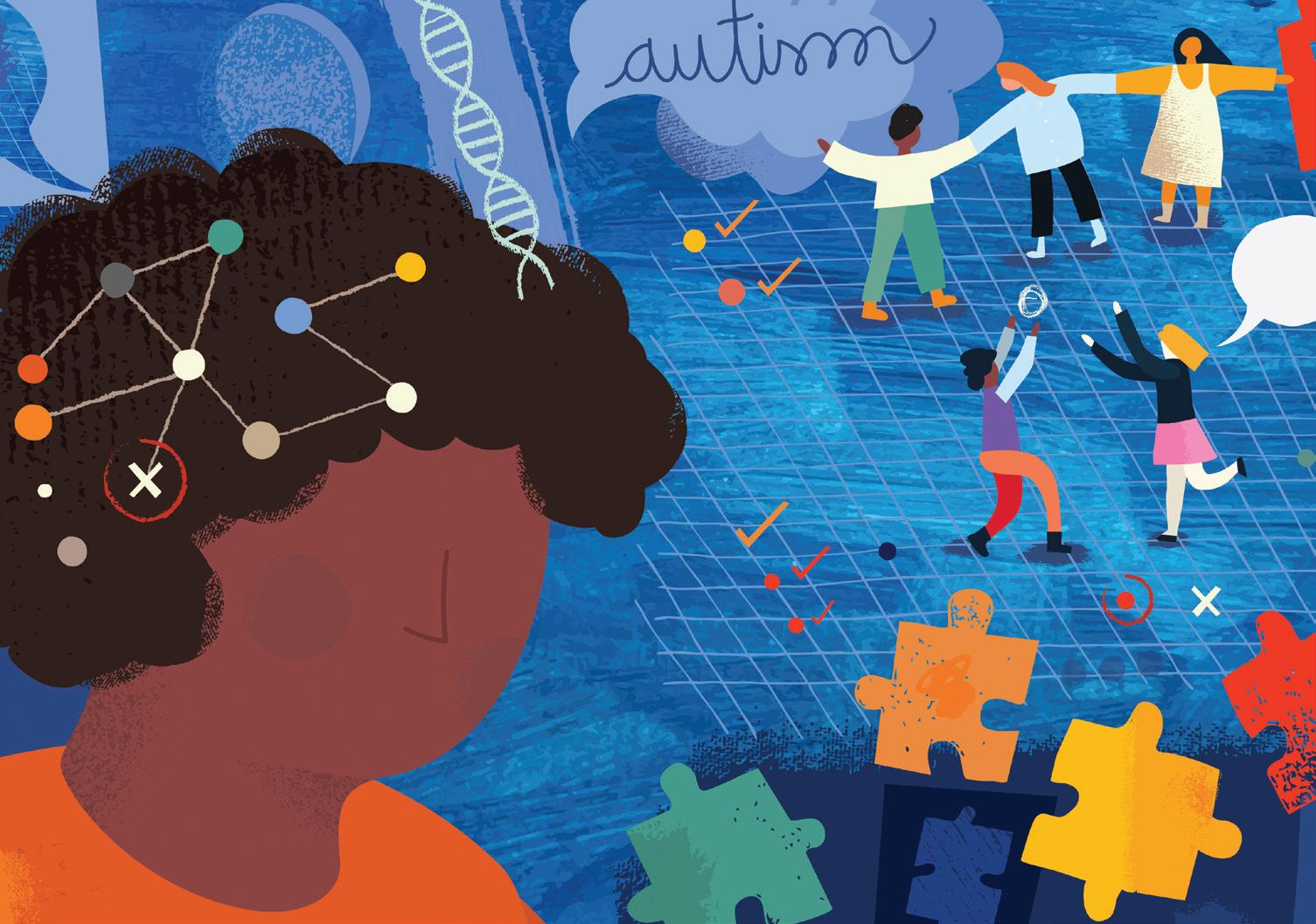
By d-mars.com News Provider
he U.S. Department of Health and Human Services provided this guide on autism spectrum disorder as part of a series of briefs that offer basic information about common disabilities and tips for educators as they support children with disabilities.
Autism spectrum disorder (ASD) is a developmental disorder that leads to distinctive social, communication, and behavioral strengths and challenges. A diagnosis of ASD now includes what used to be a few separate autism diagnoses: autistic disorder, pervasive developmental disorder not otherwise specified (PDD-NOS), and Asperger syndrome. ASD is a spectrum disorder, which means that each person with autism has a unique set of strengths and challenges.
According to the Diagnostic and Statistical Manual of Mental Disorders (DSM-5), a guide created by the American Psychiatric Association for diagnosing psychological disorders, people with ASD show:
• Difficulty communicating and interacting with other people
• Highly specific interests and repetitive behaviors
• Symptoms that affect the person’s ability to function in school, at home, and in other areas of life
Symptoms for ASD generally appear by age 2 or 3, and it can be diagnosed as early as 18 months. While research shows that early intervention can lead to positive outcomes later in life, many children are diagnosed at a much later age. The first step to supporting a child showing signs of ASD is identification. Some early signs of ASD can include little to no babbling or noise-making, delayed language development, little to no response to name, or avoiding interactions like eye contact, back-and-forth exchanges, and gesturing.
SUPPORT STRATEGIES
Educators can implement a variety of strategies to support a positive experience for children with ASD in their learning environment.
• If the child already has an Individualized Family Service Plan (IFSP) or Individualized
coordinate with the intervention
• Provide structured routines, transitions, and environments.
• Display a daily schedule with pictures of routines and activities.
• Use visual cue cards during transitions and routines to help the child predict next steps.
• Let the child know ahead of time that a transition is coming.
• Gradually increase the time the child is expected to remain on task during learning activities.
• Create, read, and discuss personalized “social stories” or “teaching stories” with the child to help them prepare for or cope with various situations.
• Create verbal and nonverbal communication opportunities.
• Create and use picture cards to cue transitions and routines.
• Create a communication book — with pictures of items or activities the child enjoys or may need to communicate about — that the child can use to communicate with others.
• Offer wait time for the child to verbalize ideas or requests.
• Read familiar, repetitive books and provide opportunities for the child to fill in the blanks.
• Limit the time spent with desired items and activities so that the child is motivated to request them again.
• Support positive social interactions.
• Use first-ten boards and cue cards to support the child while engaging in turntaking activities.
• Model, prompt, and reinforce appropriate responses to common greetings and interactions.
• Create and repeatedly read social stories with the child. Include pictures along with descriptions of activities, others’ feelings, and directives about how the child can respond in the situation.
Source: NNPA By Jason Roberts

Camping. The word itself conjures images of crackling campfires, starlit nights, and the invigorating scent of pine. It’s an escape from the daily grind, a chance to reconnect with nature, and an opportunity for adventure. But a truly memorable camping trip isn't just about the destination; it's about being prepared. The right gear can transform a potentially uncomfortable or even perilous experience into an unforgettable journey.
Before you even think about packing that extra bag of marshmallows, let's dive into the absolute must-have supplies that form the foundation of any successful camping expedition.
SHELTER:
First and foremost, you need a reliable place to sleep and take refuge from the elements.
• Tent: This is your primary shelter. Choose a tent that's appropriate for the number of people and the expected weather conditions. Consider its packed size and weight if you're backpacking. Look for features like good ventilation, a waterproof rainfly, and sturdy poles.
• Sleeping Bag: Your sleeping bag needs to match the lowest temperatures you anticipate. Sleeping bags are rated by temperature, so pay close attention to this detail. A summer bag won't cut it in nearfreezing conditions.
• Sleeping Pad: Don't underestimate the importance of a good sleeping pad. It provides insulation from the cold ground and significantly improves comfort. Options range from basic foam pads to self-inflating and air mattresses.
• Pillow (optional but recommended): While you can fashion a makeshift pillow from clothes, a small camping pillow can make a world of difference for a good night's sleep.
COOKING & SUSTENANCE:
Even if you plan to "rough it," you still need to eat!
• Camp Stove & Fuel: Unless you're relying solely on campfire cooking (which isn't always feasible or allowed), a portable camp stove is invaluable.
• Cookware: A basic set of pots, pans, and a kettle designed for camping is essential. Look for lightweight, durable materials.
• Eating Utensils & Plates/Bowls: Reusable options are more environmentally friendly than disposable ones. A "spork" can be a great space-saver.
• Cooler: Essential for keeping perishable food and drinks fresh, especially on longer trips.
• Water Bottles/Hydration Reservoir: Staying hydrated is paramount. Carry enough water for your activities and consider a water filter or purification tablets for extended trips where you'll need to source water.
• Non-Perishable Food: Think pasta, rice, canned goods, dried fruits, nuts, and energy bars. Plan your meals in advance.
• Biodegradable Soap & Sponge: For cleaning dishes.
• Trash Bags: Pack out everything you pack in! Leave no trace.
NAVIGATION & SAFETY:
Safety should always be a top priority.
• First-Aid Kit: A well-stocked first-aid kit is nonnegotiable. Include bandages, antiseptic wipes, pain relievers, blister treatment, any personal medications, and insect bite relief.
• Headlamp/Flashlight & Extra Batteries: The wilderness gets dark. A headlamp allows handsfree operation.
• Map & Compass/GPS: Even if you have a smartphone with GPS, always carry a physical map and compass and know how to use them. Batteries die.
• Multi-Tool/Knife: Incredibly versatile for various tasks, from opening cans to making minor repairs.
• Fire Starter: Waterproof matches, a lighter, or a ferro rod. Even if you don't plan a campfire, it's a vital survival tool.
• Whistle: For signaling in an emergency.
• Sunscreen & Insect Repellent: Protect yourself from the elements and pesky critters.
• Bear Canister/Bag (if applicable): In bear country, proper food storage is crucial to protect yourself and
The key to comfortable camping clothing is layering.
• Moisture-Wicking Base Layers: Help regulate body temperature by wicking sweat away from your skin.
• Insulating Mid-Layers: Fleece jackets or down vests provide warmth.
• Waterproof & Windproof Outer Layer: A good quality rain jacket and pants are essential to stay dry and protected from wind.
• Hiking Boots/Sturdy Shoes: Appropriate footwear for the terrain you'll be covering.
• Socks: Wool or synthetic socks are best for preventing blisters and managing moisture.
• Hat & Gloves: Even in warmer weather, evenings can get chilly. A hat also provides sun protection.
• Camp Chairs/Table (for car camping): Significantly enhances comfort at your campsite.
• Rope/Cord: Useful for clotheslines, tying down tarps, or minor repairs.
• Duct Tape: The ultimate fix-all!
• Toiletries: Toothbrush, toothpaste, toilet paper, hand sanitizer.
• Portable Power Bank: To charge your phone or other small electronics (use sparingly).
• Camp Lantern: Provides ambient light around the campsite.
Beyond the gear, remember that thorough planning is itself a "must-have." Research your campsite, check the weather forecast, inform someone of your itinerary, and understand any local regulations (like fire restrictions).
Camping is a fantastic way to disconnect from the digital world and reconnect with yourself and nature. With the right supplies and a bit of foresight, you'll be well-equipped to create lasting memories, whether you're a seasoned outdoors enthusiast or embarking on your very first wilderness adventure. So pack smart, stay safe, and enjoy the great outdoors!